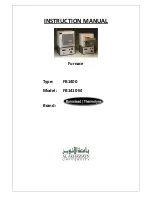
15
CAUTION:
Label all wires prior to disconnection
when servicing controls. Wiring errors
can cause improper and dangerous
operation. Verify proper operation
after servicing.
ATTENTION:
Lors des opérations d’entretien des
commandes, étiqueter tour les fi les
avant des les déconnecter. Toute er-
reur de câblage peut être une source
de danger et de panne. S’assurer du
bon fonctionnement de l’appareil
âpres tout entretien.
ELECTRICAL BRANCH SUPPLY CIRCUITS.
Route all electrical wiring to the left side of the
furnace. For installation of “A” Cabinet furnaces,
allow suffi cient slack in the wiring if an optional
cooling coil cabinet is added at a later time.
Use
of copper conductors is recommended.
WARNING:
Any attempt to operate furnace be-
fore replacing transit-mode weather
cap with upper roof jack section may
result in hazard of fi re, explosion or
asphyxiation.
Power supply circuit to the furnace must be
installed and grounded in accordance with the
National Electrical code (ANSI-C1/NFPA-70), or
Canadian Electric Code Part 1 (CSA 22-1) and
all local codes having jurisdiction.
CONNECT POWER SUPPLY WIRES
a. Remove the furnace control panel cover.
b. Insert 115 volt wires through the strain relief
on the left side of the furnace control box
(see Figure 25).
c. Connect the “hot” wire to the BLACK pigtail
lead, and the “neutral” wire to the WHITE
pigtail lead. Secure all connections with
suitable wire nuts.
d. Connect the “ground” wire to the grounding
screw.
e. Reinstall the control panel cover and secure
with the original mounting screws.
CONNECT THERMOSTAT WIRES
a. Insert 24 volt wires through the plastic grom-
met just above the control panel.
b. Connect the thermostat wires to the furnace
low voltage pigtails (see Figure 25).
c. Connect low-voltage circuit to the wall ther-
mostat.
d. A hole may be made in the furnace cabinet
to ease thermostat wiring. Make sure that the
wiring is protected from the sharp edge of the
added hole.
NOTE:
The thermostat should be installed 4 to
5 feet above the fl oor on an inside wall which
is relatively free from direct sources of heat or
cold drafts. The nominal anticipator setting is
0.4. (Refer to the thermostat literature for ad-
ditional information.)
SCREWS
COMPLETED
ASSEMBLY
TO FURNACE
UPPER ROOF
JACK (CROWN)
INNER FLUE
PIPE
FLUE ASSEMBLY
OUTER PIPE
FLASHING
WEATHER CAP
Figure 24.
















































